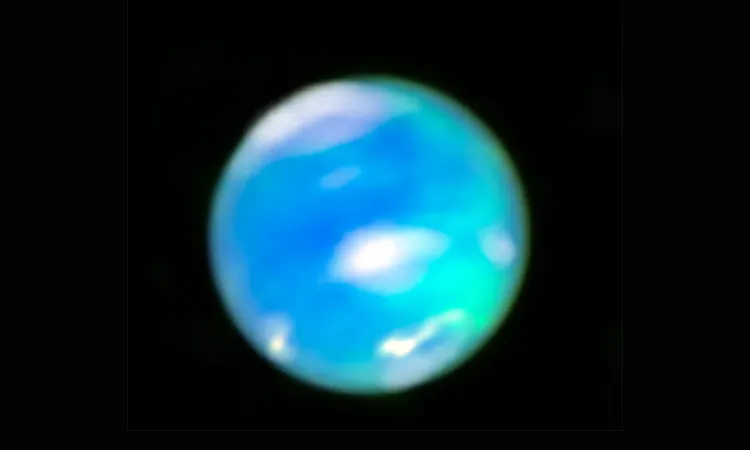
Stunning Breakthrough! First-Ever Images of Neptune's Auroras Captured by James Webb Space Telescope
2025-04-02
Author: Ling
Introduction
In an incredible leap for space exploration, astronomers have finally captured vivid images of auroras dancing across the upper atmosphere of Neptune, a phenomenon that had remained speculative until now. These groundbreaking images were made possible by NASA's James Webb Space Telescope (JWST), which offers unparalleled sensitivity in capturing near-infrared light.
Historical Context
For decades, Neptune's auroras were a mystery. Although Voyager 2 hinted at their existence during its historic flyby in 1989, subsequent observations with the most advanced telescopes on Earth could not confirm them. This changed dramatically thanks to the JWST’s remarkable capabilities.
Researchers' Insights
Lead researcher Henrik Melin from Northumbria University expressed his astonishment at the detail revealed by the Webb telescope. "Seeing these auroras in such clarity was indeed shocking," he noted, underscoring the importance of Webb's near-infrared sensitivity.
Auroral Activity
The data revealed that energetic particles, primarily originating from the Sun, strike Neptune’s ionosphere, resulting in luminescent signatures – the auroras. For the first time, researchers identified a strong emission line from H3+, a molecule closely associated with auroral activity, which appeared as striking cyan splotches in the images captured in June 2023.
Scientific Significance
What makes this discovery exciting is that H3+ has served as a reliable marker for auroras on gas giants like Jupiter, Saturn, and Uranus. However, Neptune had eluded detection until now. Heidi Hammel, a leading scientist at the Association of Universities for Research in Astronomy (AURA), emphasized the importance of this finding: “We finally have verification of auroras on Neptune, which confirms longstanding theories.”
Unique Characteristics of Neptune's Auroras
Unlike Earth, where auroras are predominantly found near the poles, Neptune's auroras are located in mid-latitudes due to the planet's magnetic field being tilted by 47 degrees from its rotation axis. This unique configuration creates a more complex interaction for solar particles and shifts the expected locations of auroras. For example, if Neptune's magnetic field were analogous to Earth's, it would mean an auroral display could occur over regions like South America instead of the polar zones.
Temperature Changes
Adding to the significance of these findings, Webb's data also indicated a considerable cooling of Neptune's upper atmosphere compared to 1989—by several hundreds of degrees, making the 2023 temperature less than half of what it was 34 years ago. This dramatic shift in temperature may explain why the planet's auroras went undetected for so long, as cooler atmospheres can diminish their brightness.
Future Research Directions
The implications of Webb's observations extend beyond Neptune. Scientists are eager to begin monitoring the planet throughout an entire solar cycle, which lasts approximately 11 years. This research could unveil further mysteries about Neptune's atmospheric and magnetic properties and their fluctuations in response to solar activity.
Conclusion
As we dream of future missions to the outer planets, insights from the Webb telescope pave the way for enhanced exploration techniques, emphasizing the importance of infrared observations. Leigh Fletcher from Leicester University noted, "Webb has opened a crucial window into the hidden ionosphere of the giant planets, revealing secrets that have long remained shrouded in darkness." With these new findings published in *Nature Astronomy*, humanity is one step closer to unlocking the mysteries of our solar system's distant worlds. The journey has only just begun!




 Brasil (PT)
Brasil (PT)
 Canada (EN)
Canada (EN)
 Chile (ES)
Chile (ES)
 Česko (CS)
Česko (CS)
 대한민국 (KO)
대한민국 (KO)
 España (ES)
España (ES)
 France (FR)
France (FR)
 Hong Kong (EN)
Hong Kong (EN)
 Italia (IT)
Italia (IT)
 日本 (JA)
日本 (JA)
 Magyarország (HU)
Magyarország (HU)
 Norge (NO)
Norge (NO)
 Polska (PL)
Polska (PL)
 Schweiz (DE)
Schweiz (DE)
 Singapore (EN)
Singapore (EN)
 Sverige (SV)
Sverige (SV)
 Suomi (FI)
Suomi (FI)
 Türkiye (TR)
Türkiye (TR)
 الإمارات العربية المتحدة (AR)
الإمارات العربية المتحدة (AR)